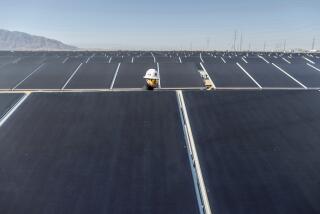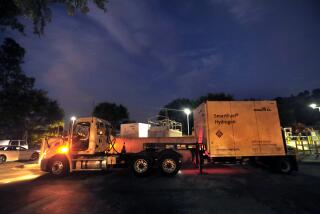Editorial: Obama’s Clean Energy Plan doesn’t go far enough

President Obama announced a major climate change plan aimed at reducing greenhouse gas emissions during an event in the White House on Aug. 3.
The coal industry already has its legal claws honed for a court battle over President Obama’s Clean Energy Plan, which was unveiled Monday, claiming that it will cost too much and render people jobless. Certainly, in the short term at least, slowing climate change by reducing carbon emissions won’t be cheap and it won’t be easy. But the science shows: We don’t have a choice. Decades of denial and delay on global warming have sharpened the need for dramatic action now.
------------
FOR THE RECORD:
Climate talks: An Aug. 4 editorial on President Obama’s Clean Energy Plan mentioned the Paris climate talks in October. They run from Nov. 30 to Dec. 11.
------------
Obama’s plan requires the reduction of carbon emissions from power plants, the nation’s single biggest source of greenhouse gases, by 32% in 2030 from what they were in 2005. States are given considerable flexibility in how they meet that goal, as long as they begin implementing their plans by 2022; California is already on track to meet and probably beat the target. Reductions would come largely by switching from coal, a particularly polluting source of power, to gas, solar and wind.
The Environmental Protection Agency has estimated that the whole program will cost about $8.4 billion, but it says that will be repaid many times over with prevention of property damage and health problems — among other things — that would occur if global warming continued unchecked. That could well be true; it’s hard to gauge the cost of global warming with real confidence. But those savings will be of little comfort now to senior citizens and working-class families who will see their electricity bills rise.
Yet this has to be done. More important than the dollar amount are the greater losses of life, home and habitat expected to result from rising seas, weather catastrophes and changes in the environment that will affect the ability to grow food or keep wildlife from extinction.
Obama’s plan represents a first, laudable federal step to rein in carbon emissions from power plants, yet even it doesn’t go far enough. It encourages the adoption of wind and solar but allows states to rely too much on natural gas, another fossil fuel, to meet their targets. The burning of gas emits half as much carbon as coal, but what happens in 2030, when the nation must look to its next big reductions in greenhouse gases? Would companies that had retooled to gas be required to retool again? Renewable resources make more sense for other reasons: Their cost drops as their use becomes more common; technology improves and equipment can be manufactured more efficiently on a large scale.
The courts already have ruled that greenhouse gases are pollutants that must be regulated by the EPA, and to win global cooperation in the climate battle, the United States must go into the Paris climate talks in October prepared to help lead the way. In this fight for survival, timid measures will not work.
Follow the Opinion section on Twitter @latimesopinion and Facebook
More to Read
A cure for the common opinion
Get thought-provoking perspectives with our weekly newsletter.
You may occasionally receive promotional content from the Los Angeles Times.






